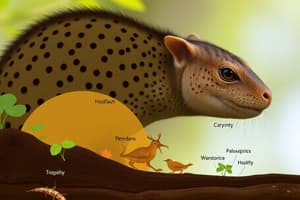Podcast
Questions and Answers
The base of a biomass pyramid is narrower than the top because there is more energy stored at higher levels.
The base of a biomass pyramid is narrower than the top because there is more energy stored at higher levels.
False (B)
Agroecosystems have higher biodiversity than natural ecosystems.
Agroecosystems have higher biodiversity than natural ecosystems.
False (B)
Acidic groundwater can enhance plant growth by providing more essential metals.
Acidic groundwater can enhance plant growth by providing more essential metals.
False (B)
Aquatic life can tolerate only minor changes in water pH, with the most fragile organisms dying first as pH decreases.
Aquatic life can tolerate only minor changes in water pH, with the most fragile organisms dying first as pH decreases.
Signup and view all the answers
Acid precipitation has no impact on the Canadian economy.
Acid precipitation has no impact on the Canadian economy.
Signup and view all the answers
Monocultures involve cultivating a single species of an organism.
Monocultures involve cultivating a single species of an organism.
Signup and view all the answers
Modern agriculture often relies on native crops that are indigenous to the region.
Modern agriculture often relies on native crops that are indigenous to the region.
Signup and view all the answers
In forests, acid soil can weaken trees, making them more susceptible to diseases and environmental stresses.
In forests, acid soil can weaken trees, making them more susceptible to diseases and environmental stresses.
Signup and view all the answers
No two species can occupy identical niches in an ecosystem.
No two species can occupy identical niches in an ecosystem.
Signup and view all the answers
Producers are found at the third trophic level of a food chain.
Producers are found at the third trophic level of a food chain.
Signup and view all the answers
Herbivores are considered secondary consumers in an ecological food chain.
Herbivores are considered secondary consumers in an ecological food chain.
Signup and view all the answers
The biosphere is dependent on the atmosphere, lithosphere, and hydrosphere.
The biosphere is dependent on the atmosphere, lithosphere, and hydrosphere.
Signup and view all the answers
The Gaia hypothesis suggests that Earth functions as an interconnected team of living and non-living things.
The Gaia hypothesis suggests that Earth functions as an interconnected team of living and non-living things.
Signup and view all the answers
The lithosphere includes all of Earth's water in solid, liquid, and gas form.
The lithosphere includes all of Earth's water in solid, liquid, and gas form.
Signup and view all the answers
Ecological pyramids are used to represent the energy and relationships between trophic levels in ecosystems.
Ecological pyramids are used to represent the energy and relationships between trophic levels in ecosystems.
Signup and view all the answers
The highest trophic level in an energy pyramid is located at the bottom.
The highest trophic level in an energy pyramid is located at the bottom.
Signup and view all the answers
Flashcards
Ecological Niche
Ecological Niche
The role a species plays in its ecosystem, including its food sources, predators, and behaviors.
Producers
Producers
Organisms that obtain energy from sunlight through photosynthesis.
Herbivores
Herbivores
Organisms that eat plants (Producers).
Carnivores
Carnivores
Signup and view all the flashcards
Omnivores
Omnivores
Signup and view all the flashcards
Food Chain
Food Chain
Signup and view all the flashcards
Ecological Pyramid
Ecological Pyramid
Signup and view all the flashcards
Gaia Hypothesis
Gaia Hypothesis
Signup and view all the flashcards
Energy Pyramid
Energy Pyramid
Signup and view all the flashcards
Biomass Pyramid
Biomass Pyramid
Signup and view all the flashcards
Engineered Ecosystem
Engineered Ecosystem
Signup and view all the flashcards
Land Uses
Land Uses
Signup and view all the flashcards
Monoculture
Monoculture
Signup and view all the flashcards
Acid Precipitation
Acid Precipitation
Signup and view all the flashcards
Buffering Capacity
Buffering Capacity
Signup and view all the flashcards
Economic Impact of Acid Precipitation
Economic Impact of Acid Precipitation
Signup and view all the flashcards
Study Notes
Ecological Niche
- A species' role in its ecosystem, encompassing what it eats, what eats it, and its behavior.
- No two species can occupy the exact same niche.
- Organisms get energy from differing sources.
- Consumers are categorized by the food they eat, such as herbivores, carnivores, omnivores, and scavengers.
Food Chains
- Show the feeding relationships between organisms.
- Example: Squirrels eat pine seeds, weasels eat squirrels, and goshawks eat weasels.
- Energy transfer occurs through the chain but is lost at each level.
Trophic Levels
- Producers (first level) – plants that use photosynthesis.
- Herbivores (second level) – animals that eat plants.
- Carnivores (third level and up) – animals that eat other animals.
Ecological Pyramids
- Diagrams showing the relationships between trophic levels.
- Energy pyramids: wider at the base (producers) and narrower at the top (carnivores).
- Energy and biomass decrease with each upward trophic level.
Terrestrial Ecosystems
- Ecosystems based on regional climate.
- Different biomes, like forests, plains, etc., exist based on these regions.
Modern Agriculture
- Agroecosystems—modified ecosystems used for farming.
- Often contain fewer diverse organisms and need human input to thrive.
- Humans introduce crops and animals to agroecosystems rather than allow a naturally self-sufficient system to develop.
- Monoculture (growing one species) can result in pest issues.
Acid Precipitation
- Acidic rainwater affects ecosystems negatively in three major ways:
- Aquatic life is harmed.
- Soil health is weakened.
- Forests are weakened and suffer damage.
- Acid precipitation negatively impacts the Canadian economy because of loss of wood/forests, decrease in fishing stocks and damage to structures.
Studying That Suits You
Use AI to generate personalized quizzes and flashcards to suit your learning preferences.
Related Documents
Description
Test your knowledge on ecological niches, food chains, and trophic levels. This quiz covers the roles of species in ecosystems and the energy transfer among different levels. Understand ecological pyramids and how energy and biomass are represented in these diagrams.




